Spatial variation of Aerosol Optical Depth and Solar Irradiance over Delhi -NCR during Summer season
Purnima Bhardwaj 1 * , Alok Kumar Pandey 1,2 , Krishan Kumar 1 and V. K. Jain 1
1
Department of Environmental Sciences,
Central University of Haryana,
Haryana,
India
DOI: http://dx.doi.org/10.12944/CWE.12.2.22
Present study shows the spatial variation of Aerosol Optical Depth (AOD), solar irradiance and their association at the urban and rural sites in Delhi and National Capital Region (NCR) during the summer season of the year 2015. Summer-time AOD data from the NASA’s Terra satellite MODIS sensor has been used to study the spatial distribution of aerosols over Delhi and its surrounding rural area. The ground data for the direct and global solar irradiances was collected over this region at urban and rural locations in Delhi and NCR using a Fieldspec Spectro-radiometer. HYSPLIT model has been used for the air mass trajectory analysis. The AOD values were observed to be higher over Delhi compared to the relatively lower AOD in rural area of NCR. The NCR site observed higher average solar irradiances than Delhi during the summer season. This may be because of the higher aerosol concentration in Delhi as compared to its outskirts. Also, this region is affected by the severe dust storm events during the summer season which further increases the aerosol load in the atmosphere. HYSPLIT results show the influence of western Thar Desert air masses on the Delhi-NCR. Windblown as well anthropogenic aerosols play a major role in scattering and absorption of the incoming solar radiation and hence, in governing the micro-climatology of the region.
Copy the following to cite this article:
Bhardwaj P, Pandey A. K, Kumar K, Jain V. K. Spatial variation of Aerosol Optical Depth and Solar Irradiance over Delhi -NCR during Summer season. Curr World Environ 2017;12(2). DOI:http://dx.doi.org/10.12944/CWE.12.2.22
Copy the following to cite this URL:
Bhardwaj P, Pandey A. K, Kumar K, Jain V. K. Spatial variation of Aerosol Optical Depth and Solar Irradiance over Delhi -NCR during Summer season. Curr World Environ 2017;12(2). Available from: http://www.cwejournal.org/?p=17313
Download article (pdf)
Citation Manager
Publish History
Select type of program for download
| Endnote EndNote format (Mac & Win) | |
| Reference Manager Ris format (Win only) | |
| Procite Ris format (Win only) | |
| Medlars Format | |
| RefWorks Format RefWorks format (Mac & Win) | |
| BibTex Format BibTex format (Mac & Win) |
Article Publishing History
| Received: | 2017-06-19 |
|---|---|
| Accepted: | 2017-07-10 |
Introduction
Aerosol and air pollution play a crucial role in the urban climatology. Urbanization, industrial development, biomass burning and fossil fuel combustion processes due to growing anthropogenic activities have led to increasing the air pollution that also interferes in the microclimatology of a city.1,2,3 Increasing aerosol loading has caused health related problems associated with air quality problems and has also impacts on the aviation safety due to reduction in the visibility4. Aerosols and other pollutants significantly reduces the incoming solar radiation due to scattering and absorptions. Solar radiation data is essential not only for scientific and industrial applications to develop highly efficient solar energy systems but also for a wide variety of other applications such as medical, agricultural, designing of the buildings, atmospheric chemistry and physics.5,6 According to Iqbal,7 solar radiation is characterized by the three main components: direct beam, diffuse radiation, and global radiation and are governed by various factors such as solar zenith angle, seasons, aerosols and their properties, ozone level, altitude of the region, surface albedo, etc. Delhi-NCR is located in the western part of the Indo-Gangetic Plains (IGP) region in northern India. As Delhi-NCR is a rapidly urbanizing area, it is more prone to changes in its climatology. Solar irradiance plays a major role in governing the climatology of the region in addition to the other above mentioned applications and therefore it is highly important to be investigated as extensively as possible. This region has seen changes in its air quality and climatology such as an increase in temperature over the city compared to the surrounding rural areas by the formation of urban heat islands (UHIs).8,9 Also, high temperatures especially during summer season increases the convection and uplifting of dust. In conjunction with strong surface winds, this region is affected by the severe dust storm events in summer season.10,11 Over the last decade, various studies have been carried out to study the light absorption by the aerosols and their implications on the radiative forcing over Delhi and outside Delhi such as those based on AOD measurements12,13; SSA, AOD and Angstrom coefficient due to dust aerosols.14 But very few studies have been carried out regarding global, direct and diffuse radiation of the incoming solar radiation over Delhi-NCR. Latha and Badrinath15 studied the solar irradiance (global and diffuse) variation due to air pollution over Hyderabad. Seasonal AOD variability has been studied by Ali et al.16 using satellite over a decadal long period of time over Saudi Arabia. However, there have not been many studies regarding the relation between various components of solar irradiance and AOD over this region. This paper attempts to study the solar irradiance and the aerosol optical depth (AOD) over the Delhi-NCR region in the summer season.
Sampling Sites
Sampling was carried out for the summer season in the months of May-June 2015 at two locations in Delhi-NCR viz., Shahdara, Delhi (28.68°N, 77.29°E) which is an urban site and Sampla, Haryana (28.77°N, 76.76°E) in NCR which is situated around 66km away NW of Delhi, which represents a rural site. Sampling sites are shown in Figure 1. Delhi, national capital of India, is one of the highly populated and ever growing megacities, with the population of over 16 million17. Shahdara is one of the highly urbanized areas of Delhi consisting of both the residential as well as industrial establishments. Sampla site was, on the other hand, surrounded mainly by the agricultural fields. A few factory establishments and one or two brick kilns are established at a distance of approximately 10kms away from the sampling site. Delhi-NCR falls in a semiarid climate zone with long summers and temperature going up to as high as 45°C during daytime18. The average annual rainfall in this region is approximately 670mm.
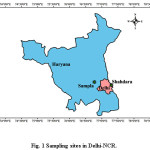 |
|
Materials and Methods
The global and direct components of the incoming solar irradiance were measured using a broadband handheld FieldSpec Spectro-radiometer (ASD Inc.) under cloud free conditions. This instrument collects spectra in the wavelength range 300nm-1100nm in visible and near infrared range. This instrument is limited by the absence of the automatic sun tracking facility. Therefore, manual operations by the observer assured the correctness of the measurements and ascertained the absence of clouds. At both the sites, the instrument was placed at the roof of the building to ensure a clear 180 degrees field of view (FOV) for the instrument. Continuous measurements of global and direct irradiance were carried out at an interval of 15 minutes from 11.00 am to 4.00 pm in the months of May-June 2015. Morning and evening time sampling has been avoided as the Sun position changes more rapidly in morning and evening and therefore it is not possible to gather the accurate solar irradiance using handheld FieldSpec Spectro - radiometer. For the measurement of global irradiance, a remote cosine receptor (RCR) was attached to the spectro-radiometer. For the direct irradiance measurement, 2π field of view for measuring global irradiance was restricted with a narrow pipe, coated with black carbon surface on the inner side fitted with a 2 degree FOV disc. This narrow pipe was then pointed towards the solar disc and using the shadow technique direct irradiance measurements was made. View Spec pro software was used for further analysis of the collected data.
MODIS (Moderate Resolution Imaging Spectro-radiometer) is a sensor mounted on the Terra and Aqua Satellites of NASA’s EOS (Earth Observing System) Mission having 36 spectral channels in the range 0.405 and 14.385 μm, which provide information about the Earth Atmosphere, Ocean and Land Condition. Terra and Aqua are sun-synchronous, near polar satellites having different equator crossing times i.e. 10.30am/pm and 1.30pm/am respectively covering the whole earth’s surface every 1-2 days (http://modis.gsfc.nasa.gov/data). MODIS datasets (MOD04_L2 data from Terra platform) were used to retrieve AOD values over this region for the period of May-June 2015. NCEP re-analysis data have been downloaded from the NOAA website (ftp://ftp.arl.noaa.gov/pub/archives/reanalysis) for Hybrid Single-Particle Lagrangian Integrated Trajectory (HYSPLIT) model configuration. HYSPLIT model control file has been configured to run model at different heights for the three days backward trajectory analysis.
Results and Discussion
Figure 2 and 3 show the variation of the average global irradiance and average direct irradiance over Delhi-NCR respectively, in summer 2015. The average global solar irradiance was found to be higher at Sampla (maximum=1.15Wm-2nm-1at 537 nm) than Shahdara (maximum=1.04Wm-2nm-1at 537 nm) in summer season. Global irradiance for the two sampling sites shows a significant variation in the visible region (VR) and near infrared region (NIR) of the solar spectrum. Similar variations in global irradiance have been reported over Hyderabad by Latha and Badrinath.15 But at shorter and longer wavelengths there is not much variation in the global solar irradiance at the two sampling sites. The average direct irradiance was found to be higher in Sampla with (maximum=0.37Wm-2nm-1 at 612nm) than Shahdara (maximum=0.34Wm-2nm-1 at 562nm) in summer 2015. Direct irradiance is found to be varying considerably from around 487nm in the VR and NIR of the solar spectra; however, not much variation for the direct irradiance can be seen at the beginning of visible region for the two sampling sites.
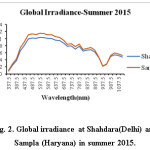 |
|
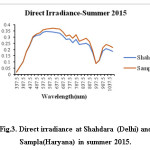 |
|
Haziness of the atmosphere also plays a great role in the solar attenuation.19 Hazy sky conditions prevailed over Delhi-NCR throughout the summer season because of significant amount of anthropogenic emissions such as vehicular, from coal based thermal power plants which are also a source of sulfate, nitrate and carbonaceous aerosols, and dust from large scale constructional activities.13,19,20,21,22 AOD spatial map (Figure 4) over the Delhi-NCR showed a relatively much higher AOD values (0.72-0.99) in the Delhi as compared to rural area outside Delhi (0.32-0.63) in summer season. Pandithurai et al.14 reported that AOD at 0.5 mm increases from 0.55 (March) to 1.2 (June) due to dust aerosol over New Delhi during pre-monsoon and a decrease in Angstrom exponent from 1.28 (March) to 0.47 (June) indicating an increased amount of coarse particles due to dust storms from nearby Thar region. Pandey et al.8 reported higher values of AOD confined to the highly built-up areas of Delhi as compared to the surrounding rural region which are pre-dominantly agricultural land. Another important parameter for the high AOD could be the presence of Black Carbon emissions in urban areas.23
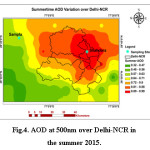 |
|
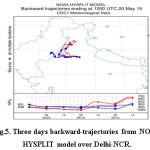 |
|
Rural areas mainly consist of vast open agricultural fields, unlike the urban areas, which in dry summer season become the source of re-suspended dust in the atmosphere. Also, the frequent dust storm events in the pre-monsoon season (March-June), locally known as ‘Aandhi’,14 also increases the amount of coarse mode particles in the atmosphere thereby greatly influencing the solar spectral irradiance over the region. The mineral dust mixed with the anthropogenic pollutants also affects the solar insolation significantly in this region.24 The solar spectral irradiance measurements and AOD are found to be in conjunction with each other. As is evident from the result, the solar spectral irradiance is observed to be less in Shahdara (high AOD) as compared to high solar irradiance in Sampla (low AOD). Emissions from the thermal power plants and vehicles are the prominent sources of the aerosols and other air pollutants over the New Delhi. Apart from local emissions summer -time windblown dust from the Thar desert also contributed to the aerosol load over the Delhi.25
HYSPLIT model three days backward trajectories (Figure 5) were drawn from the sampling sites to understand the air mass trajectories over the studied period. Out of all the HYSPLIT model results, the 20th May 2015 is being taken as the representative air mass trajectory which showed that the study region air masses are influenced by the north-western air mass becoming the source of dust and other pollutants from nearby Thar Desert and other north-western regions.
The solar spectral irradiance measurements were carried out at two different sites in Delhi-NCR. The average global and direct solar irradiance were observed to be higher at Sampla (rural, NCR site) than Shahdara (urban, Delhi site) in the summer season of the year 2015. The presence of high levels of air pollution in the urban area and presence of large amount of dust after frequent dust storms and re-suspended dust from open fields in the rural area could be the main factors affecting solar irradiance. The AOD values were observed to be more in Delhi as compared to NCR which is in accordance with the measured solar irradiances. HYSPLIT model results indicate the north-western influence on the air masses over the study region.
Acknowledgement
The authors are thankful to acknowledge the NASA GES DISC which develops and maintain the Moderate Resolution Imaging Spectroradiometer (MODIS) scientific and data support teams, for making the data available. Purnima Bhardwaj acknowledges the University Grant Commission (UGC), MHRD, Government of India for financial support to this work.
References
- Gharibzadeh, M., Alam, K., Bidokhti, A.A., Abedini, Y., Masoumi, A., 2017. Radiative effects and optical properties of aerosol during two dust events in 2013 over Zanjan, Iran. Aerosol Air Qual. Res. 17, 888–898. doi:10.4209/aaqr.2016.04.0161
CrossRef - Bibi, H., Alam, K., Chishtie, F., Bibi, S., Shahid, I., Blaschke, T., 2015. Intercomparison of MODIS, MISR, OMI, and CALIPSO aerosol optical depth retrievals for four locations on the Indo-Gangetic plains and validation against AERONET data. Atmos. Environ. 111, 113–126. doi:10.1016/j.atmosenv.2015.04.013
CrossRef - Pandey, A.K., Kumar, R.P., Kumar, K., 2015. Satellite and ground based seasonal variability of NO 2 and SO 2 over New Delhi, India 9640, 96400U. doi:10.1117/12.2193542
CrossRef - Lau, K.M., Ramanathan, V., Wu, G.X., Li, Z., Tsay, S.C., Hsu, C., Sikka, R., Holben, B., Lu, D., Tartari, G., Chin, M., Koudelova, P., Chen, H., Ma, Y., Huang, J., Taniguchi, K., Zhang, R., 2008. The joint aerosol-monsoon experiment: A new challenge for monoon climate research. Bull. Am. Meteorol. Soc. 89, 369–383. doi:10.1175/BAMS-89-3-369
CrossRef - Lam, J. C., & Li, D. H. W. Correlation between global solar radiation and its direct and diffuse components. Building and Environment,31(6): 527-535 (1996).
CrossRef - Kaskaoutis, D. G., Kambezidis, H. D., Jacovides, C. P., & Steven, M. D. Modification of solar radiation components under different atmospheric conditions in the Greater Athens Area,Greece. Journal of Atmospheric and Solar-Terrestrial Physics, 68(10): 1043-1052 (2006).
CrossRef - Iqbal, M. An Introduction to Solar Radiation. Academic Press, Toronto, Canada (1983).
- Pandey, A. K., Singh, S., Berwal, S., Kumar, D., Pandey, P., Prakash, A., and Kumar, K. Spatio- temporal variations of urban heat island over Delhi. Urban Climate,10:119-133(2014).
CrossRef - Berwal, S., Kumar, D., Pandey, A. K., Singh, V. P., Kumar, R., & Kumar, K. Dynamics of thermal inertia over highly urban city: a case study of Delhi. SPIE Remote Sensing, International Society for Optics and Photonics, (pp. 100080E-100080E),(2016).
- Dey, S., Tripathi, S.N., Singh, R.P. and Holben, B.N. Influence of Dust Storms on the Aerosol Optical Properties over the Indo-Gangetic Basin. Journal of Geophysical Research: Atmosphere, 109 (D20) (2004).
CrossRef - Prasad, A.K. and Singh, R.P. Changes in Aerosol Parameters during Major Dust Storm Events (2001- 2005) over the Indo-Gangetic Plains Using AERONET and MODIS Data. Journal of Geophysical Research: Atmosphere,112(D9) (2007)
CrossRef - Singh, S., Nath, S., Kohli, R., & Singh, R. Aerosols over Delhi during preâ€monsoon months: Characteristics and effects on surface radiation forcing. Geophysical Research Letters,32(13) (2005).
CrossRef - Sharma, M., Kaskaoutis, D. G., Singh, R. P., & Singh, S. Seasonal variability of atmospheric aerosol parameters over Greater Noida using ground sunphotometer observations.Aerosol and air quality research, 14(3): 608-622 (2014)
CrossRef - Pandithurai, G., S. Dipu, K. K. Dani, S. Tiwari, D. S. Bisht, P. C. S. Devara, and R. T. Pinker. Aerosol radiative forcing during dust events over New Delhi, India. Journal of Geophysical Research113, (D13209) (2008).
CrossRef - Latha, K. M., &Badarinath, K. V. S. Spectral solar attenuation due to aerosol loading over an urban area in India. Atmospheric Research,75(4): 257-266 (2005).
CrossRef - Ali, M.A., Assiri, M., Dambul, R., 2017. Seasonal Aerosol Optical Depth (AOD) Variability Using Satellite Data and its Comparison over Saudi Arabia for the Period 2002?2013. Aerosol Air Qual. Res. 17, 1267–1280. doi:10.4209/aaqr.2016.11.0492
CrossRef - Census of India 2011, Economic Survey of Delhi (2012-13), Chapter 2 - Demographic Profile: 8-26. (http://delhi.gov.in/DoIT/DoIT_Planning/ES2012-13/EN/ES_Chapter%202.pdf).
- Guttikunda, S. K., &Gurjar, B. R. Role of meteorology in seasonality of air pollution in megacity Delhi, India.Environmental monitoring and assessment, 184(5): 3199-3211 (2012).
CrossRef - Ramanathan, V., Crutzen, P. J., Lelieveld, J., Mitra, A. P., Althausen, D., Anderson, J., ... and Clarke, A. D. Indian Ocean Experiment: An integrated analysis of the climate forcing and effects of the great Indoâ€Asian haze. Journal of Geophysical Research: Atmospheres,106(D22): 28371-28398 (2001).
CrossRef - Prasad, A. K., Singh, R. P., andKafatos, M. Influence of coal based thermal power plants on aerosol optical properties in the Indo-Gangetic basin. Geophysical Research Letters,33(5) (2006).
CrossRef - Prasad, A.K., Singh, R.P. and Kafatos, M. Influence of Coal-based Thermal Power Plants on the Spatial-temporal Variability of Tropospheric NO2 Column over India. Environmental Monitoring and Assessment,184(4): 1891–1907 (2012).
CrossRef - Singh, S., Soni, K., Bano, T., Tanwar, R.S., Nath, S. and Arya, B.C. Clear-sky Direct Aerosol Radiative Forcing Variations over Mega-city Delhi. Annales Geophysicae. 28(5): 1157-1166(2010).
CrossRef - Latha, K. M., &Badarinath, K. V. S. Seasonal variations of black carbon aerosols and total aerosol mass concentrations over urban environment in India. Atmospheric Environment, 39(22): 4129-4141 (2005).
CrossRef - Srivastava, S. K., Srivastava M. K., Saha, A., Tiwari, S., Singh, S., Dumka,U. C., Singh, B. P., and Singh., N. P. Aerosol optical properties over Delhi and Manora Peak during a rare dust event in early April 2005.International Journal of Remote Sensing,32(23): 7939-7954(2011).
CrossRef - Lodhi, N.K., Beegum, S.N., Singh, S., Kumar, K., 2013. Aerosol climatology at Delhi in the western Indo-Gangetic Plain: microphysics, long-term trends, and source strengths. J. Geophys. Res. 118, 1–15
CrossRef






